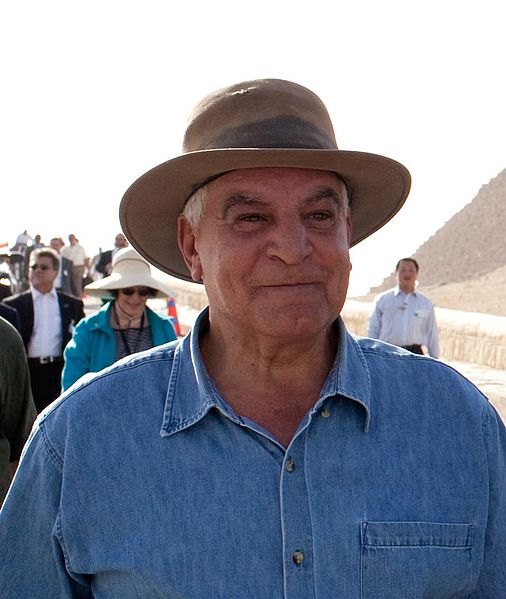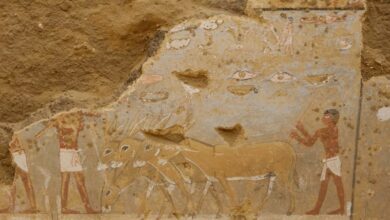
Celebrated Egyptian archeologist and former Minister of Antiquities Zahi Hawass recently divulged a number of “secrets” about the ancient Egyptians’ enthralling civilization, which continues to inspire wonder today, during an interview with Egyptian TV presenter Lamis Elhadidy on her program “Al Kahera Alan” (Cairo Now) on Al Hadath (The Event) channel.
During the interview, Hawass also dispelled a number of popular myths about the ancient Egyptians, including rumors of the “Pharaohs’ curse,” the existence of “Moses’s Pharaoh” and the mysterious substance “red mercury,” among others.
The ‘Pharaohs’ Curse’
Hawass insisted that the “Pharaohs’ curse” is nothing more than a myth, recounting an amusing story about one of his team members who believed that entering the crypt located inside the Sphinx’s tail was an invitation to be cursed. Hawass said that he has been through the crypt in question with the Belgian King, and nothing happened to them!
Moreover, the prominent Egyptologist clarified that if any tomb accommodating a mummy was kept open for 300 years, it is certain that deadly bacteria would grow there. For this reason, Hawass said he usually leaves the tomb open so to allow in fresh air.
Tutankhamen not a victim of foul play
Hawass also explained in his interview that Tutankhamen was diagnosed with several diseases and conditions, such as malaria and flatfoot, adding that the ancient king suffered from poor blood circulation to his feet. Hawass added that scientists have determined through an x-ray of King Tut’s brain that the real cause of his death was not murder.
Some believe that the young king was the victim of foul play because of an injury to the top of his head. However, Hawass told Hadidy during the interview that the injury can be attributed to the mummification process.
He previously vowed during an interview with the Italia 1 Channel that he would unveil to the world the truth behind King Tutankhamen’s death by 2020. Hawass added in the same interview that DNA tests are helping to reveal the facts related to the death of the boy pharaoh.
No archeological proof for ‘Moses’s Pharaoh’
Hawass also asserted that there is no archeological evidence confirming the identity of the pharaoh who ruled during the arrival of the Prophets Moses and Joseph to Egypt, adding that information currently available on the issue is limited to guesses and speculation.
Who broke the Sphinx’s nose?
Hawass began by saying that he has done a number of comprehensive studies on the Sphinx, which he usually references during information sessions that he regularly gives in front of the statue at Giza’s pyramids.
While discussing the controversial stories that have circulated about the sphinx in Giza, Hawass said that he receives nearly 70 emails a week from fans and ancient Egypt enthusiasts, a small fraction of whom believe that aliens built the Sphinx, asking him to excavate under the statue for proof.
However, his usual response is that he will never allow people coming from the UK or New York to excavate under and around the remarkable statue, adding that engineers from Cairo University’s engineering center have previously duh 32 holes under the statue, confirming that the sphinx is made of simple stones and rejecting the possibility that otherworldly beings may have played a role in its construction.
Hawass explained that the Shinx represents King Khafre and features the ancient ruler on a lion’s body to depict his strength. He further pointed out that all the crypts that surround the Sphinx were dug by normal people looking for treasures, with the crypts having been tunneled in 500 B.C.
The famed Egyptologist also stressed that the Pyramids were built by the ancient Egyptian pharaohs, denying that they were constructed by slaves. If this were true, Hawass said, the Pharaohs would not have been buried next to the pyramids.
There are 124 pyramids across Egypt in total, he added.
Most importantly, Hawass refuted any and all claims about Napleon’s role in damaging the Sphinx’s nose, saying that according to Al-Maqrizi, a Sufi named Saem Eldahr broke the statue’s nose after growing angry over what he perceived as people worshipping the statue.
70 percent of monuments have not yet been discovered
Hawass noted that Modern Egypt was built on the remains of Ancient Egypt, referring to an incident when he met a family that had managed to excavate the remarkable archeological site of Tune Elgabal. Hawass recalled demanding to know what they were doing, but they answered that they were on their own property.
Anything that is located under the ground belongs to the state, Hawass said, stressing the archeological value of areas such as Ein Shams, Akhmim, and Nazlet Al-Seman. For this reason, Hawass pointed out, he usually says that only 30 percen of Egypt’s ancient monuments have been unearthed, with 70 percent still waiting to be discovered.
First industrial area in ancient Egypt
Hawass also revealed that the first industrial area dating back to the Pharaonic era was discovered in 2017, adding that the site houses several workshops that used to be used in making tombs for ancient Egypt’s kings.
He also added that archaeologists are currently working toward the discovery of Queen Nefertiti tomb. Hawass told leading UK news outlet Express.co.uk in November that he hopes to discover the location of Queen Nefertiti’s tomb in “a matter of weeks.”
The famed Egyptologist told the English newspaper that Egypt’s Valley of the Kings, where Hawass currently works in Luxor, houses the burial site of the legendary ancient queen. He went on to explain that he expects to uncover all of the tombs belonging to the 18th Dynasty’s queen as well as tombs belonging to the children of various Kings, adding that recent research points to the existence of an unidentified burial site belonging to Egypt’s ancient royals located near the tomb of Amenhotep III.
‘Red Mercury’ is not real
Hawass also confirmed that “red mercury” does not exist, adding that rumors of the mysterious substance, which some say is a healing elixir found in the mouths of ancient Egyptian mummies, is simply a myth circulated by Egyptian social media users.




